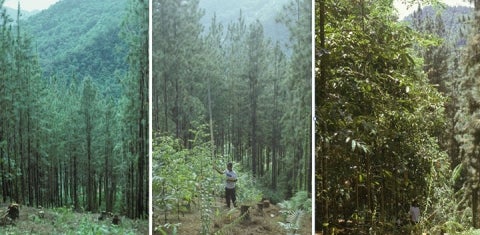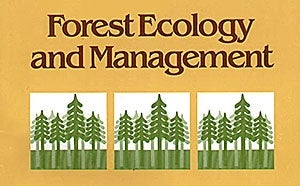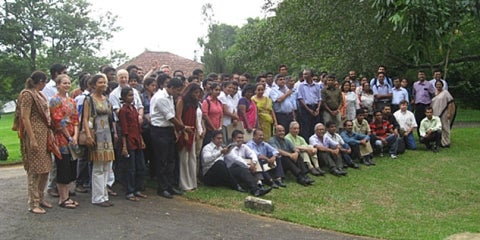Note: Yale School of the Environment (YSE) was formerly known as the Yale School of Forestry & Environmental Studies (F&ES). News articles and events posted prior to July 1, 2020 refer to the School's name at that time.
 This series of photographs depicts the growth of native tree plantings beneath a Caribbean pine plantation at the World Heritage Sinharaja Man and the Biosphere Reserve in southwest Sri Lanka. The photo on the far left depicts the site before planting. The second photo, center, shows the site after two years, while the photo on the far right shows the site six years after planting.
This series of photographs depicts the growth of native tree plantings beneath a Caribbean pine plantation at the World Heritage Sinharaja Man and the Biosphere Reserve in southwest Sri Lanka. The photo on the far left depicts the site before planting. The second photo, center, shows the site after two years, while the photo on the far right shows the site six years after planting.
A series of research papers on tropical forest restoration in South Asia that originated during a conference of the F&ES-based Environmental Leadership and Training Initiative (ELTI) has been published in a special issue of the journal Forest Ecology and Management.
ELTI is an F&ES-based project that works in collaboration with both the Smithsonian Tropical Research Institute and the National University of Singapore to train landholders, practitioners, and decision-makers across the Neotropics and tropical Asia to advance the conservation and restoration of native tree cover and ecosystem integrity in multiple-use, human-modified landscapes.
ELTI is an F&ES-based project that works in collaboration with both the Smithsonian Tropical Research Institute and the National University of Singapore to train landholders, practitioners, and decision-makers across the Neotropics and tropical Asia to advance the conservation and restoration of native tree cover and ecosystem integrity in multiple-use, human-modified landscapes.

The special issue, titled “Restoring Working Forests in Human Dominated Landscapes in South Asia,” came out of a 2012 ELTI conference in Sri Lanka’s Peradeniya Botanic Gardens. The event was held to disseminate findings on tropical forest restoration to policymakers and practitioners in the region.
The issue [Volume No. 329 (2014)] is composed of seven papers covering a range of issues, including the ecological aspects of native species reforestation, the effects of land use on bird flocks and diversity, estimated carbon levels in relation to forest fragmentation, and the underlying drivers of forest diversity in sacred forests.
According to researchers, the Sri Lanka region has been at the cutting edge of tropical forest restoration and management largely because of a strong commitment from universities, non-governmental organizations, and local government, as well as the region’s long cultural history of land use and tree crop cultivation.
The issue was organized by Prof. Mark Ashton ’85 M.F. ’90 Ph.D., the Morris K. Jesup Professor of Silviculture and Forest Ecology and Director of School Forests at F&ES; with Uromi Goodale ’01 M.F.S. ’09 Ph.D., who is now Associate Professor at Guangxi University, China; and David Neidel ’06 Ph.D., the Asia Program Coordinator for ELTI.
Much of the work published in the special issue is based on a F&ES partnership that started in 1985 with two Sri Lankan Universities — the University of Peradeniya and the University of Sri Jaywardenapura. Two F&ES doctoral students and 20 F&ES master’s students collaborated with over 30 Sri Lankan graduate students and faculty and helped contribute to a body of work that comprises field guides, two books, and more than 100 peer review papers.
The resource issues around restoring human-dominated landscapes in tropical South Asia are complex and can be divided into topics concerning forest fragmentation and restoration, Ashton said.
Several papers in the special issue focus on effects of forest fragmentation. One study shows declines in forest structure and standing carbon stocks within fragmented forests as compared to contiguous forest. Another study demonstrates changes in bird composition and flock density in relation to land use — especially between forests, the forest buffer zones, and agricultural lands (tea, coffee). And a third study suggests that the origins of many sacred groves were as ancient forest fragments and that their future role is one of cultural, social and ecological centers of reforestation within deforested landscapes.
Studies that focus on restoration demonstrated: 1) the benefits of single-species timber plantations as mechanisms to establish second growth forests and native species plantings beneath for both economic and conservation purposes; 2) the values of incorporating indigenousplants that produce non-timber forest products in forest restoration programs; and 3) the importance of controlling fire and protection from herbivory as treatments that can facilitate natural forest regeneration in human-made montane grasslands.
Five years ago the partnership between F&ES, Peradeniya and Sri Jayewardenapura created an NGO called the “Sri Lanka Program for Forest Conservation” which has built its own field station and started acquiring land for the purpose of research and demonstrating forest restoration and conservation practices for landowners. This summer two F&ES masters students, Jaeeun Sohng and Klaus Geiger, conducted their studies at the station adjacent to the World Heritage Sinharaja Rain Forest.
The issue [Volume No. 329 (2014)] is composed of seven papers covering a range of issues, including the ecological aspects of native species reforestation, the effects of land use on bird flocks and diversity, estimated carbon levels in relation to forest fragmentation, and the underlying drivers of forest diversity in sacred forests.
According to researchers, the Sri Lanka region has been at the cutting edge of tropical forest restoration and management largely because of a strong commitment from universities, non-governmental organizations, and local government, as well as the region’s long cultural history of land use and tree crop cultivation.
The issue was organized by Prof. Mark Ashton ’85 M.F. ’90 Ph.D., the Morris K. Jesup Professor of Silviculture and Forest Ecology and Director of School Forests at F&ES; with Uromi Goodale ’01 M.F.S. ’09 Ph.D., who is now Associate Professor at Guangxi University, China; and David Neidel ’06 Ph.D., the Asia Program Coordinator for ELTI.
Much of the work published in the special issue is based on a F&ES partnership that started in 1985 with two Sri Lankan Universities — the University of Peradeniya and the University of Sri Jaywardenapura. Two F&ES doctoral students and 20 F&ES master’s students collaborated with over 30 Sri Lankan graduate students and faculty and helped contribute to a body of work that comprises field guides, two books, and more than 100 peer review papers.
The resource issues around restoring human-dominated landscapes in tropical South Asia are complex and can be divided into topics concerning forest fragmentation and restoration, Ashton said.
Several papers in the special issue focus on effects of forest fragmentation. One study shows declines in forest structure and standing carbon stocks within fragmented forests as compared to contiguous forest. Another study demonstrates changes in bird composition and flock density in relation to land use — especially between forests, the forest buffer zones, and agricultural lands (tea, coffee). And a third study suggests that the origins of many sacred groves were as ancient forest fragments and that their future role is one of cultural, social and ecological centers of reforestation within deforested landscapes.
Studies that focus on restoration demonstrated: 1) the benefits of single-species timber plantations as mechanisms to establish second growth forests and native species plantings beneath for both economic and conservation purposes; 2) the values of incorporating indigenousplants that produce non-timber forest products in forest restoration programs; and 3) the importance of controlling fire and protection from herbivory as treatments that can facilitate natural forest regeneration in human-made montane grasslands.
Five years ago the partnership between F&ES, Peradeniya and Sri Jayewardenapura created an NGO called the “Sri Lanka Program for Forest Conservation” which has built its own field station and started acquiring land for the purpose of research and demonstrating forest restoration and conservation practices for landowners. This summer two F&ES masters students, Jaeeun Sohng and Klaus Geiger, conducted their studies at the station adjacent to the World Heritage Sinharaja Rain Forest.
 Speakers and participants during the 2012 ELTI conference at Peradeniya Botanic Gardens, Sri Lanka.
Speakers and participants during the 2012 ELTI conference at Peradeniya Botanic Gardens, Sri Lanka.
Published
September 9, 2014